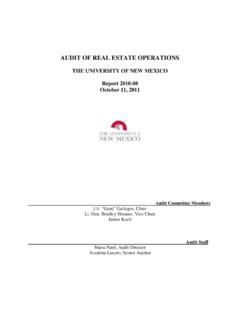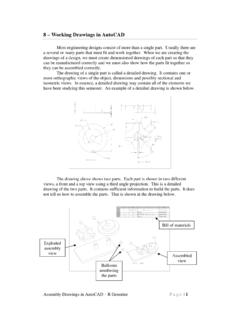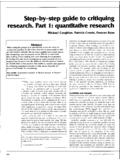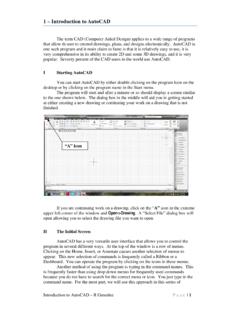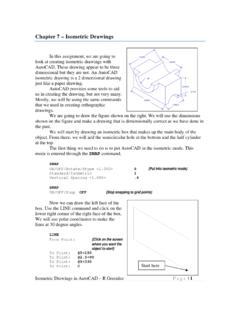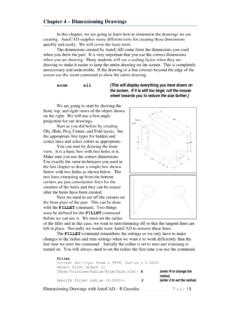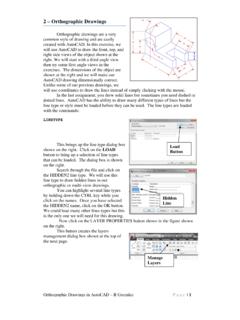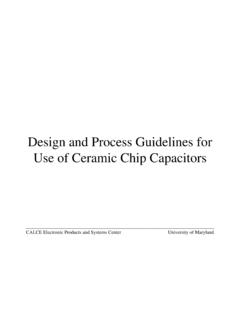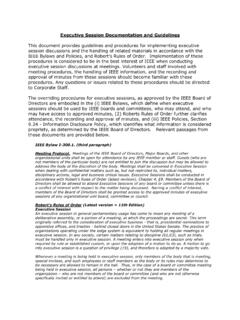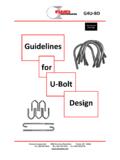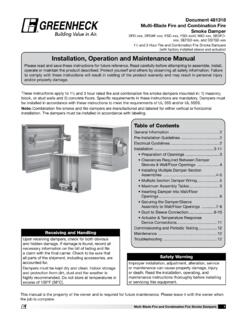Transcription of Design for Manufacturing - Guidelines
1 1 Information taken from Computer-Aided Manufacturing , Second Edition, Tien-Chien chang, Richard AWysk, and Hsu-Pin Wang. Pages 596 to 598. Prentice Hall 1998 Design for Manufacturing - GuidelinesDesign for Manufacturing (DFM) and Design for assembly (DFA) are the integration of product designand process planning into one common activity. The goal is to Design a product that is easily and economicallymanufactured. The importance of designing for Manufacturing is underlined by the fact that about 70% ofmanufacturing costs of a product (cost of materials, processing, and assembly ) are determined by designdecisions, with production decisions (such as process planning or machine tool selection) responsible for only20%.
2 The heart of any Design for Manufacturing system is a group of Design principles or Guidelines that arestructured to help the designer reduce the cost and difficulty of Manufacturing an item. The following is a listingof these the total number of parts. The reduction of the number of parts in a product is probably thebest opportunity for reducing Manufacturing costs. Less parts implies less purchases, inventory, handling,processing time, development time, equipment, engineering time, assembly difficulty, service inspection,testing, etc. In general, it reduces the level of intensity of all activities related to the product during itsentire life.
3 A part that does not need to have relative motion with respect to other parts, does not have tobe made of a different material, or that would make the assembly or service of other parts extremelydifficult or impossible, is an excellent target for elimination. Some approaches to part-count reductionare based on the use of one-piece structures and selection of Manufacturing processes such as injectionmolding, extrusion, precision castings, and powder metallurgy, among a modular Design . The use of modules in product Design simplifies Manufacturing activitiessuch as inspection, testing, assembly , purchasing, redesign, maintenance, service, and so on.
4 One reasonis that modules add versatility to product update in the redesign process, help run tests before the finalassembly is put together, and allow the use of standard components to minimize product variations. However, the connection can be a limiting factor when applying this of standard components. Standard components are less expensive than custom-made items. Thehigh availability of these components reduces product lead times. Also, their reliability factors are wellascertained. Furthermore, the use of standard components refers to the production pressure to thesupplier, relieving in part the manufacture s concern of meeting production parts to be multi-functional.
5 Multi-functional parts reduce the total number of parts in adesign, thus, obtaining the benefits given in rule 1. Some examples are a part to act as both an electricconductor and as a structural member, or as a heat dissipating element and as a structural member. Also,there can be elements that besides their principal function have guiding, aligning, or self-fixturing featuresto facilitate assembly , and/or reflective surfaces to facilitate inspection, parts for multi-use. In a Manufacturing firm, different products can share parts that have beendesigned for multi-use.
6 These parts can have the same or different functions when used in differentproducts. In order to do this, it is necessary to identify the parts that are suitable for multi-use. Forexample, all the parts used in the firm (purchased or made) can be sorted into two groups: the firstcontaining all the parts that are used commonly in all products. Then, part families are created by definingcategories of similar parts in each group. The goal is to minimize the number of categories, the variationswithin the categories, and the number of Design features within each variation.
7 The result is a set ofstandard part families from which multi-use parts are created. After organizing all the parts into partfamilies, the Manufacturing processes are standardized for each part family. The production of a specificpart belonging to a given part family would follow the Manufacturing routing that has been setup for itsfamily, skipping the operations that are not required for it. Furthermore, in Design changes to existingproducts and especially in new product designs, the standard multi-use components should be for ease of fabrication.
8 Select the optimum combination between the material and fabricationprocess to minimize the overall Manufacturing cost. In general, final operations such as painting,polishing, finish machining, etc. should be avoided. Excessive tolerance, surface-finish requirement, andso on are commonly found problems that result in higher than necessary production separate fasteners. The use of fasteners increases the cost of Manufacturing a part due to thehandling and feeding operations that have to be performed. Besides the high cost of the equipmentrequired for them, these operations are not 100% successful, so they contribute to reducing the overallmanufacturing efficiency.
9 In general, fasteners should be avoided and replaced, for example, by using tabsor snap fits. If fasteners have to be used, then some guides should be followed for selecting the number, size, and variation used; also, utilize standard components whenever screws that are too long, or too short, separate washers, tapped holes, and round heads and flatheads(not good for vacuum pickup). Self-tapping and chamfered screws are preferred because they improveplacement success. Screws with vertical side heads should be selected vacuum assembly directions.
10 All parts should be assembled from one direction. If possible, the bestway to add parts is from above, in a vertical direction, parallel to the gravitational direction (downward). Inthis way, the effects of gravity help the assembly process, contrary to having to compensate for its effectwhen other directions are compliance. Errors can occur during insertion operations due to variations in part dimensionsor on the accuracy of the positioning device used. This faulty behavior can cause damage to the part and/orto the equipment. For this reason, it is necessary to include compliance in the part Design and in theassembly process.
